
Grevillea is a diverse genus of about 360 species of evergreen flowering plants in the family Proteaceae, native to rainforest and more open habitats in Australia, New Guinea, New Caledonia, Sulawesi and other Indonesian islands east of the Wallace Line. It was named in honour of Charles Francis Greville, an 18th century patron of botany and co-founder of the Royal Horticultural Society. The species range from prostrate shrubs less than 50 cm (20 in) tall to trees 35 m (115 ft) tall. Common names include grevillea, spider flower, silky oak and toothbrush plant. Closely related to the genus Hakea, the genus gives its name to the subfamily Grevilleoideae.

Grevillea aquifolium is a shrubby or scrambling plant endemic to South Australia and Victoria. Common names include holly grevillea, prickly grevillea or variable prickly grevillea. In occurs naturally in woodland, open forest and heathland.
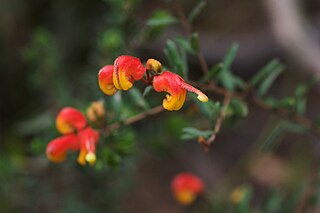
The Australian flowering shrub Grevillea alpina has several common names, including mountain grevillea, alpine grevillea, and cat's claws. It is not limited to alpine environments, and in fact is less common at high elevation than low. The species is variable in appearance, with five general forms described: small-flowered, Grampians, Northern Victorian, Goldfields, and Southern Hills forms. It is found in dry forests and woodlands across Victoria and into southern New South Wales. Some forms of the plant are low to the ground, and some become a spreading shrub. The flowers come in many colours, from white to green to shades of red and pink, or a pattern of several colours. The curled flowers are 1 to 3 centimetres in length. It is attractive to nectar-feeding insects and birds.

Grevillea 'Superb' is a widely grown grevillea cultivar bred by Merv Hodge in Queensland. It is a hybrid of a white-flowered Grevillea banksii, from Queensland, and the Western Australian plant G. bipinnatifida.

Grevillea 'Robyn Gordon' is a grevillea cultivar which has been planted widely in Australia and other countries.

Grevillea 'Honey Gem' is a grevillea cultivar originating from Queensland in Australia.
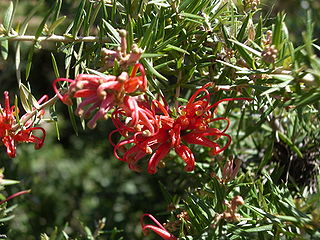
Grevillea juniperina, commonly known as juniper- or juniper-leaf grevillea or prickly spider-flower, is a plant of the family Proteaceae native to eastern New South Wales and south-eastern Queensland in Australia. Scottish botanist Robert Brown described the species in 1810, and seven subspecies are recognised. One subspecies, G. j. juniperina, is restricted to Western Sydney and environs and is threatened by loss of habitat and housing development.

Rosa 'La France' is a pink rose cultivar found in France in 1867 by the rosarian Jean-Baptiste André Guillot (1827–1893). It is generally accepted to be the first hybrid tea rose. Its introduction is therefore also considered the birth of the modern rose. As the cultivar was not systematically bred, its hybrid parentage can only be speculated, but 'Madame Falcot' is considered as a possible parent.
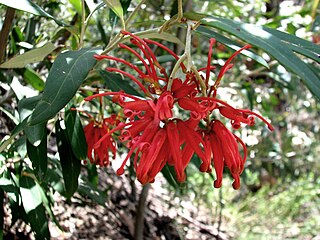
Grevillea victoriae, also known as royal grevillea or mountain grevillea, is a shrub which is endemic to south-eastern New South Wales and mountainous parts of Victoria in Australia.

Grevillea lavandulacea, commonly known as lavender grevillea, is endemic to south-eastern South Australia and western and central Victoria.

Grevillea 'Peaches and Cream' is new and much sought-after grevillea cultivar which has been recently released in Australia.
Grevillea 'Fire Sprite' is a grevillea cultivar. It is a cross between G. longistyla and G. venusta. First developed in 1996, it was registered with the Australian Cultivar Registration Authority (ACRA) in 2007. It has a shrubby habit, reaching 3 m (10 ft) high and 5 m (15 ft) wide.
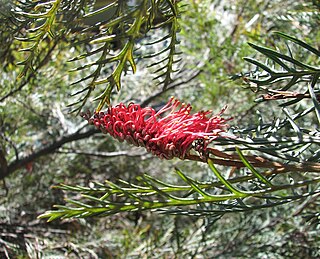
Grevillea 'Red Hooks' is a grevillea cultivar from Australia. It is a shrub that grows to 3 metres in height and 4 to 5 metres in width and has pinnate leaves with narrow-linear lobes. The inflorescences comprise greyish-green perianths and red styles which bend backwards. After being grown for many years under the misnomers Grevillea hookeriana or Grevillea hookerana, the cultivar was registered in 1987 under the name 'Red Hooks'. It is thought to be a hybrid of G. longifolia x G. tetragonoloba.

Grevillea stenomera, commonly known as lace net grevillea, is a shrub in the family Proteaceae. It is endemic to Western Australia, occurring between Kalbarri and Tamala.
Grevillea pteridifolia is a species of Grevillea native to Australia. Common names include silky grevillea, Darwin silky oak, ferny-leaved silky oak, fern-leaved grevillea, golden grevillea, golden tree and golden parrot tree. It occurs in Western Australia, Northern Territory, and Queensland.
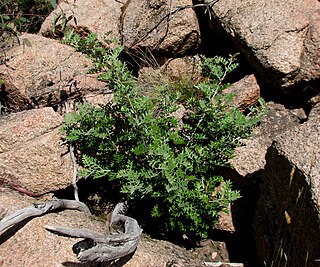
Grevillea willisii is a shrub species which is endemic to the eastern highlands of Victoria, in Australia. Common names include Omeo Grevillea and Rock Grevillea.

Grevillea parallela, also known as silver oak, beefwood or white grevillea, is a tree native to northern Australia.
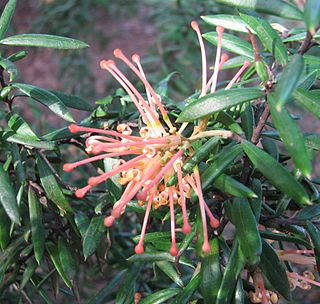
Grevillea 'Poorinda Queen' is a grevillea cultivar that originates from Australia.
Grevillea rudis is a shrub of the genus Grevillea native to an area along the west coast in the Wheatbelt region of Western Australia.
















